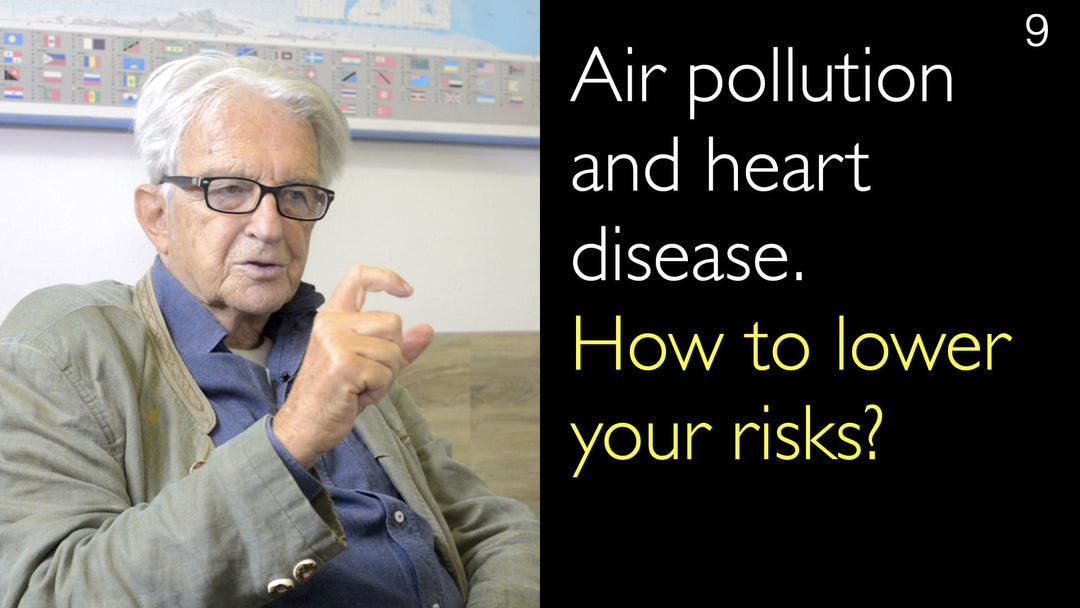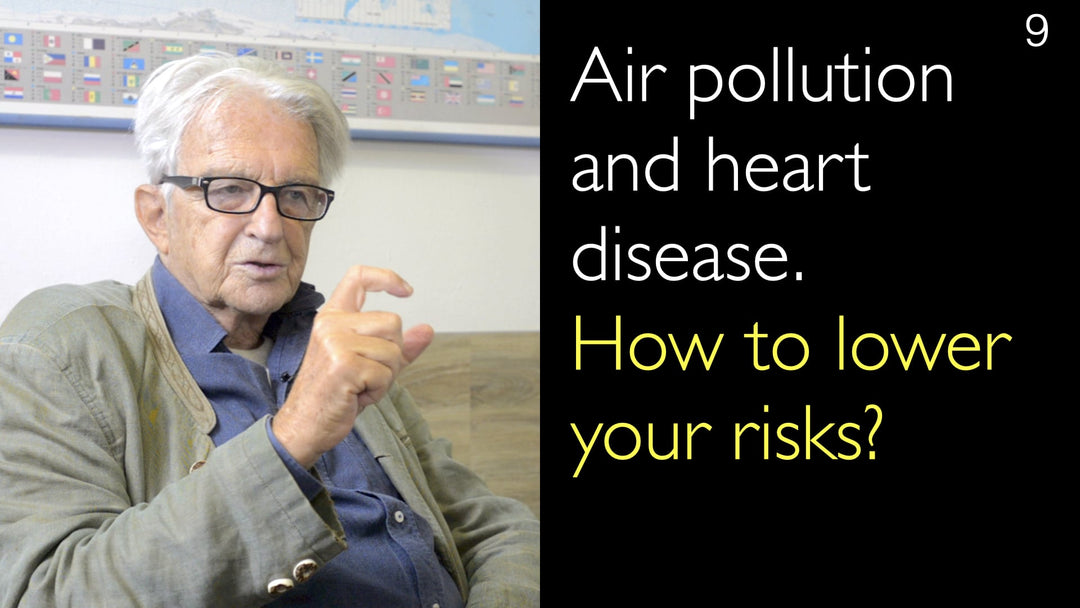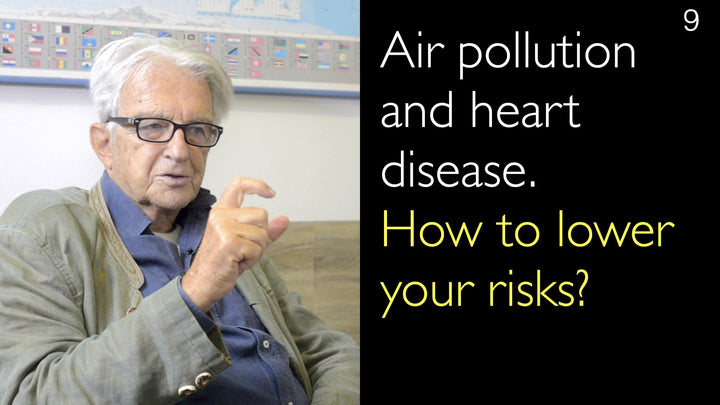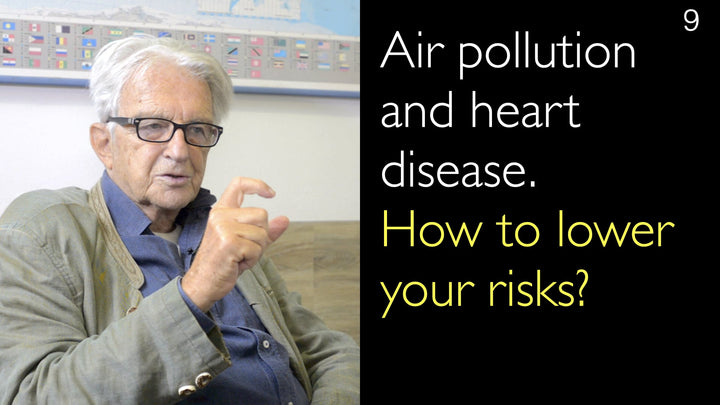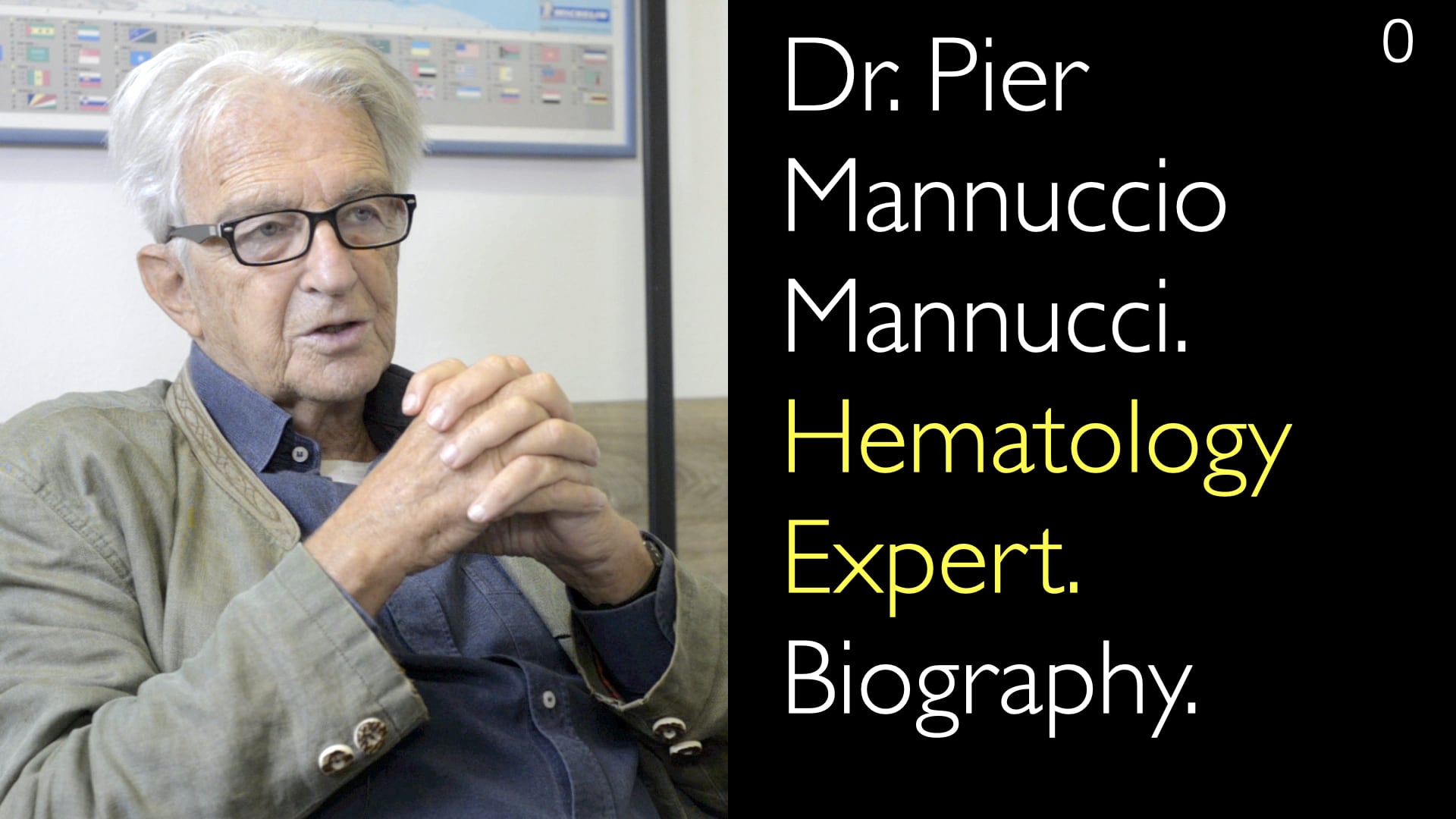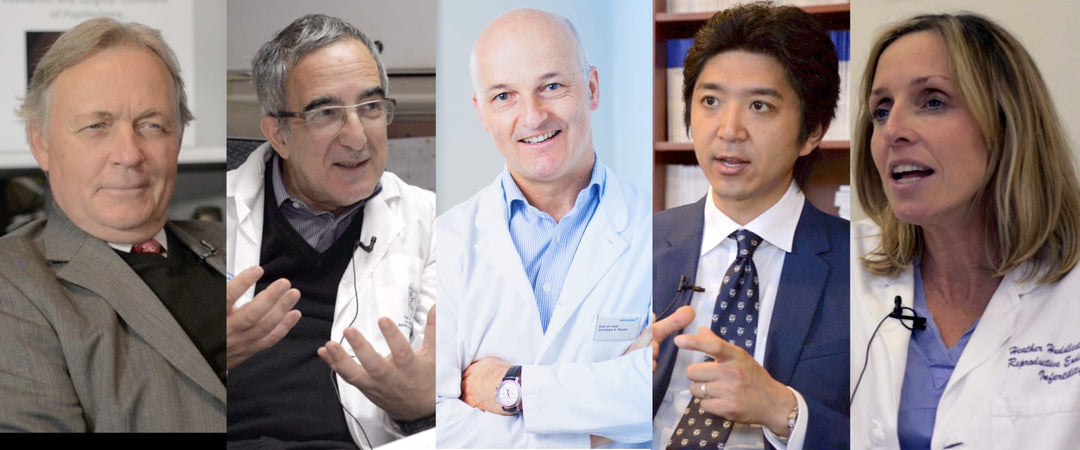Luftföroreningar och hjärt-kärlsjukdom: Mekanismer, risker och förebyggande
Hoppa till avsnitt
- Hur luftföroreningar orsakar hjärtsjukdom
- Global påverkan och dödlighetsstatistik
- WHO:s uppdaterade luftkvalitetsriktlinjer
- Huvudkällor till luftföroreningar
- Individuella skyddsstrategier
- Fullständig transkription
Hur luftföroreningar orsakar hjärtsjukdom
Finpartikulärt materia, känt som PM2.5, är en primär orsak till hjärt-kärlsjukdom från luftföroreningar. Dr. Pier Mannucci, MD, förklarar att dessa mikroskopiska partiklar från lungorna absorberas direkt in i blodomloppet. När de är i cirkulation aktiverar PM2.5-partiklar blodplättar och koagulationssystemet, vilket skapar ett tillstånd av hyperkoagulabilitet. Detta ökar avsevärt risken för atrotrombotiska händelser som kranskärlssjukdom och ischemisk stroke.
Dr. Mannucci beskriver ytterligare en andra kritisk mekanism: systemisk inflammation. PM2.5-exponering orsakar en mild men ihållande aktivering av det inflammatoriska systemet. Denna kroniska inflammation bidrar direkt till bildandet och utvecklingen av aterosklerotiska plack. Kombinationen av hyperkoagulabilitet och inflammation skapar en perfekt storm för arteriell trombos. Dessutom försämrar dessa partiklar blodkärlens förmåga att vidgas, vilket leder till vaskonstriktion och hypertoni.
Global påverkan och dödlighetsstatistik
Den globala hälsoeffekten av luftföroreningar är djupgående och ofta underskattad. Dr. Pier Mannucci, MD, uppger att luftföroreningar orsakar nästan 10 miljoner undvikbara dödsfall årligen. Denna siffra utgör en betydande andel av planetens årliga 60 miljoner dödsfall. Som riskfaktor för dödlighet rankas luftföroreningar precis efter hypertoni, en diagnos de själva kan orsaka.
Dr. Pier Mannucci, MD, betonar begreppet "befolkningsattributiv fraktion". Medan rökning är en starkare riskfaktor för en individ, är luftföroreningars risk mer genomgripande över hela populationer. En individ kan välja att undvika rökning, men ingen kan undvika att andas. Denna universella exponering gör luftföroreningar till en unikt utmanande folkhälsokris. Effekterna sträcker sig bortom hjärt-kärl- och lungsjukdomar till att inkludera ökad cancerrisk och, som nyare forskning visar, en högre risk för för tidiga förlossningar hos gravida kvinnor.
WHO:s uppdaterade luftkvalitetsriktlinjer
Med erkännande av de allvarliga hälsofaran har Världshälsoorganisationen nyligen skärpt sina luftkvalitetsriktlinjer. Dr. Pier Mannucci, MD, framhåller att den säkra gränsen för PM2.5-partiklar halverades från 10 mikrogram per kubikmeter till endast 5 mikrogram per kubikmeter. Denna förändring implementerades eftersom de tidigare gränserna ansågs otillräckliga för att skydda människors hälsa, med den idealiska säkra gränsen som troligen är noll.
De nya riktlinjerna avslöjar en skarp verklighet för stadsbefolkningar. Dr. Pier Mannucci, MD, noterar att även under de gamla, mindre strikta gränserna, var endast 10 % av europeiska stadsområden i linje med dem. Detta innebär att en överväldigande 90 % av europeiska städer upplevde farliga nivåer av luftföroreningar. De uppdaterade, strängare standarderna placerar nu en ännu större brådska på regeringar och kommuner att genomföra effektiva policyer som minskar utsläpp och förbättrar luftkvaliteten för sina medborgare.
Huvudkällor till luftföroreningar
Bekämpning av luftföroreningar kräver förståelse för dess olika källor, som varierar efter region och säsong. Dr. Pier Mannucci, MD, identifierar flera nyckelbidragare utöver den vanligt citerade biltrafiken. Uppvärmning av hem och kontor, särskilt i kallare klimat, är en stor källa till föroreningar. Detta demonstrerades tydligt under COVID-19-lockdowns; i nordkinesiska städer som Beijing hade reducerad trafik en mindre inverkan på luftkvaliteten eftersom värmesystemen förblev i drift.
Andra betydande källor inkluderar jordbruksaktiviteter. Ammoniak, en biprodukt från djurhållning och gödslingsanvändning, bidrar till partikelbildning. Naturliga källor, såsom damm från öknar, spelar också en roll. Dr. Mannucci kopplar lösningen till den bredare klimatkrisen och noterar att boven ofta är användningen av fossilt kol. Övergång till elfordon, förbättring av byggnadsisolering för uppvärmning och minskning av total trafik är väsentliga steg som adresserar både luftföroreningar och koldioxidutsläpp samtidigt.
Individuella skyddsstrategier
Medan systemförändring är avgörande kan individer ta proaktiva steg för att minska sin personliga exponering för skadliga luftföroreningar. I sin diskussion med Dr. Anton Titov, MD, erbjuder Dr. Pier Mannucci, MD, flera praktiska, evidensbaserade rekommendationer. Den mest effektiva personliga skyddsutrustningen är en välpassande FFP2-mask, som filtrerar bort fina partiklar mycket bättre än en standard kirurgmask. Han förespråkar fortsatt användning av dessa masker i högförorenade stadsmiljöer, även efter pandemin.
Beteendejusteringar kan också minska den dagliga exponeringen avsevärt. Dr. Mannucci råder att undvika enkelriktade gator och områden med tung trafik när man promenerar eller tränar. Att välja rutter genom parker eller grönområden, där föroreningsnivåer generellt är lägre, är mycket fördelaktigt. Att välja att gå eller cykla för korta resor istället för att köra minskar både personlig exponering och bidrar till att sänka samhällets föroreningsnivåer. Han är tydlig med att ingen medicinering, såsom aspirin, rekommenderas för att motverka de inflammatoriska effekterna av föroreningar, vilket gör dessa praktiska undvikandestrategier till det bästa försvaret för en individ.
Fullständig transkription
Dr. Anton Titov, MD: Luftföroreningar leder till ökad incidens av hjärtsjukdom och lungsjukdom över hela världen. Inverkan av fina partiklar, det vill säga PM2.5, på hjärt- och lungsjukdomar är ännu större än vi tidigare trott. Hur bidrar luftföroreningar till kranskärlssjukdom, hjärtsvikt, hypertoni och hjärtarytmier?
Dr. Pier Mannucci, MD: Jag är glad att du ville betona särskilt hjärt-kärlsjukdom, eftersom det är ganska förståeligt och plausibelt att luftföroreningar, särskilt de fina partiklarna eller gaserna, påverkar lungsystemet eftersom vi alla andas flera gånger under dagen. Det är lite svårare att förstå varför luftföroreningar är en stor orsak till hjärt-kärlsjukdom. Luftföroreningar är förmodligen viktigare för hjärtsjukdom än för lungsjukdom.
Jag ska försöka förklara det eftersom det är en del av den nyare kunskapen och min erfarenhet. Särskilt partiklarna, i synnerhet de fina partiklarna. Dessa partiklar har en diameter på 2,5 mikrometer (PM2.5) och mindre än 0,1 mikrometer. De tränger inte bara in i andningssystemet i lungorna, utan de kommer också in i blodcirkulationen.
Från lungorna absorberas fina partiklar in i blodcirkulationen. Deras PM2.5-partiklar beter sig genom att aktiverar blodkoagulation. De aktiverar blodkoagulation och skapar ett tillstånd av hyperkoagulabilitet. PM2.5-partiklar aktiverar trombocyter. Det är så det finns en ökad risk för atrotrombotisk hjärt-kärlsjukdom, som kranskärlssjukdom, och cerebral kärlsjukdom, och stroke.
PM2.5-partiklar orsakar också inflammation. De orsakar inflammation, vilket är en orsak till atrotrombos. Det är trombos på grund av hyperkoagulabilitet och ateroskleros. Det beror på bildandet och förhöjt tillstånd av det inflammatoriska systemet. PM2.5-partiklar skapar en mild men pågående aktivering av det inflammatoriska systemet.
Detta går ihop med bildandet av aterosklerotiska plack tillsammans med hyperkoagulabilitet. Det är bildandet av tromber i det arteriella systemet. Därför, mycket kortfattat, orsakar PM2.5-partiklar hjärt-kärlsjukdom. De orsakar också hypertoni genom samma mekanism. PM2.5-partiklar förändrar också mekanismen för blodkärlsdilatation av artärerna. Det är så PM2.5-partiklar orsakar vaskonstriktion. Så dessa är orsakerna till hypertoni.
I allmänhet orsakar PM2.5-partiklar många andra sjukdomar, som cancer. PM2.5-partiklar skapar ett låggradigt inflammatoriskt systemtillstånd. Det är så PM2.5-partiklar orsakar fler tumörer. Mycket nyligen fanns det evidens att PM2.5-partiklar orsakar för tidiga förlossningar. Det är en mycket nyligen publicerad studie. De har visat en mycket hög risk för för tidig förlossning hos kvinnor exponerade för luftföroreningar.
Så luftföroreningar orsakar direkt och indirekt nästan 10 miljoner dödsfall, undvikbara dödsfall, varje år. Om du överväger att planeten har 60 miljoner dödsfall varje år, representerar 10 miljoner en existentiell fraktion. Luftföroreningar i rankingarna av riskfaktorer för död kommer efter hypertoni. Men luftföroreningar, inklusive PM2.5-partiklar, kan orsaka hypertoni.
Otillräcklig kost och rökning bidrar till dödsfall. Men återigen, du överväger att rökning är något du kan undvika eftersom det beror på individuella beslut. Samtidigt kan du inte undvika att andas. Och det är därför luftföroreningar inte är den första riskfaktorn för dödlighet och funktionsnedsättning i världen. Men luftföroreningar är risken som är mer genomgripande.
Luftföroreningar, PM2.5-partiklar, är vad epidemiologin kallar "den högsta befolkningsattributiva fraktionen" eftersom rökning kan vara en starkare riskfaktor på individnivå. Men på populationsnivå är rökning inte så genomgripande. Du måste överväga det faktumet om Europa, som också gäller för andra kontinenter. Endast 10 % av stadsområdena i Europa uppfyller de rekommenderade gränserna för luftföroreningar som inte är farliga för hälsan.
De etablerade den nedre gränsen för luftföroreningar som är farliga för hälsan. Så, allt som är över denna gräns är farligt för hälsan. Och en del av saken är att mycket nyligen—och detta är en ny faktor från för några veckor sedan—Världshälsoorganisationen har ytterligare minskat denna gräns. Gränserna för luftföroreningar anses inte särskilt farliga. Men de uppnås inte i de flesta stadsområden i Europa och andra höginkomstländer.
Nu har gränserna för luftföroreningar ytterligare minskats. Varför? Eftersom de såg att denna luftföroreningsgräns är svår att uppnå och upprätthålla. Dessa gränser var otillräckliga. Så, syftet är att indikera de nedre gränserna för acceptabla luftföroreningar som inte är farliga för hälsan. Förmodligen är "ingen fara för hälsan"-gränsen noll. Men var medveten om att de inte kan nå noll luftföroreningar; Världshälsoorganisationen föreslog att halvera gränserna från 10 partiklar per miljon för PM2.5-partiklar till 5 partiklar per miljon för PM2.5-partiklar.
Europa måste för närvarande ratificera den lägre gränsen. Så återigen, låt oss säga att Amerika är bättre ställt i det avseendet eftersom de nyligen är närmare de sista gränserna för WHO:s gränser på 10 partiklar per miljon. Men det är fortfarande mycket otillräckligt, enligt WHO, eftersom luftföroreningsgränser nu går till fem PM2.5-partiklar per miljon. Detta gäller för PM2.5-partiklar, men det gäller naturligtvis också gaser som kvävedioxid.
Återigen undrar ni säkert vad som kan göras, med tanke på denna dystra situation? Vad kan göras för att förbättra luftkvaliteten? Inte mycket, eftersom det naturligtvis är att minska utsläppen av föroreningar som är den enkla lösningen. Och vi måste komma ihåg att de främsta källorna till luftföroreningar varierar mellan länder. Men de påverkas säkert av biltrafik, även om det inte är den enda källan till luftföroreningar.
Till exempel är det också uppvärmning av bostäder och andra arbetsplatser. Det finns också damm som kommer från öknen. Naturligtvis finns det, som jag nämnde, ammoniak som är en biprodukt från djuruppfödning och även från odling av grönsaker. Så det är inte särskilt lätt.
Vad kan göras? Jag tror att problemet hänger ihop med klimatförändringarna på grund av dessa två saker. Den skyldige är naturligtvis, å ena sidan, PM2.5-partiklarna (partiklar med en aerodynamisk diameter mindre än 2,5 mikrometer), och å andra sidan är det koldioxid. Men allt beror på användningen av produkter som innehåller kol.
Och därför tror jag att, som jag säger, elbilar, ett bättre system för att värma hus och minskad trafik. Det är detta som gör att vi kan undvika användningen av fossilt kol. Fossilt kol används fortfarande i stor utsträckning, som ni vet, av Kina, också av Indien, och även i Europa av Polen.
Så vad kan göras åt luftföroreningar? Det är verkligen ett stort problem. Och så säger folk okej, men ni berättar mycket dramatiska saker, ni ger oss några ord. Men vad kan göras? Vad kan vi göra på individnivå, med tanke på att vi inte kan kontrollera vad som görs av regeringarna?
Och där kan jag ge några råd. Men naturligtvis kan jag inte helt lösa problemet med luftföroreningar eftersom luftföroreningsproblemet är över individnivå. Det är ett problem för landet och hela jordklotet, hela världen. Hör nu, vi bor i en stad som är mycket förorenad eftersom den ligger på en slättmark, med mycket lite vind. Och vi är inte de enda.
Det finns exempel, jag är säker, i ert land, till exempel. I Polen, i Krakow-regionen. Det finns andra exempel i Europa på städer som har lite vind och relativt lite regn, förutom nyligen, och mycket trafik och också låga temperaturer.
Och det enda vi kan göra för att undvika luftföroreningar är att vidta vissa åtgärder. En åtgärd är denna. Det är inte kirurgmasken utan FFP2-masken. Eftersom de filtrerar åtminstone partiklarna. Kirurgmasken gör mycket lite, men de är bättre än ingenting.
Så jag tror att vi kommer att fortsätta använda denna mask när pandemiproblemet är över. Vi kommer att använda FFP2, särskilt när vi är ute på gatorna. Naturligtvis finns det också bättre filter, men de är omöjliga att bära. De är omöjliga att bära i vardagslivet. Men dessa är användbara FFP2-masker som blev kända för oss alla under pandemin.
Sedan andra råd som jag kan ge oss är, till exempel, när du går i staden, undvik enkelriktade gator. Eftersom det uppenbarligen kommer att vara mer trafik än på tvåvägsgator. Undvik bilparkering utanför kontoret. Hur ska jag kunna uppnå det? För när bilar startar motorer, släpper de ut mycket partiklar.
Undvik att springa i områden där det är mycket trafik. Det kan finnas en närliggande park, där föroreningarna per definition kommer att vara mindre. Förbättra uppvärmningen av kontoren eller husen eftersom det är en viktig del av föroreningarna. Och jag ska ge er ett exempel.
Under epidemin i Kina var naturligtvis lockdown mycket strängare än det har varit i våra länder. Likaså skedde verkligen en stark minskning av föroreningar. Men främst skedde en minskning av kväveoxid, som främst beror på biltrafik.
I Wuhan, där pandemin startade, som ligger mer i centrala/södra Kina, var detta förhållande annorlunda jämfört med Beijing. Eftersom i Beijing, i landets norra del, var lockdown mycket mindre effektivt. Varför? Eftersom den norra staden behöver värma kontor och bostäder.
Så under lockdown var ingen trafik mycket mindre effektivt för att minska luftföroreningar i Beijing än i Wuhan på grund av värmen. Så vi tillskriver mycket ansvar för luftföroreningar till biltrafik. Men naturligtvis också till uppvärmning. Och den andra saken jag nämnde.
Så jag kan ta ett annat exempel på skillnaden mellan Wuhan och även de södra städerna i Kina, och Beijing som ligger i norr, och det är kallt. Så till exempel är det tydligt att här i Milano har vi skillnader jämfört med Rom, eftersom de ligger längre söderut. Även under vintern i Rom har de viss uppvärmning som inte är lika stark som här.
Så jag kan förstå vad som händer i S:t Petersburg eller vad som händer i Moskva. Så jag tror att det inte är ett lätt problem att lösa. Och jag tror att den enda lösningen är nästa generation—ni. Unga människor i detta land gör också en stor ansträngning för att tackla klimatkrisen. Eftersom de på så sätt också kommer att tackla problemet med föroreningar som har minskat i Storbritannien jämfört med för 20 år sedan.
Tillbaka till den punkt jag nämnde för er, WHO:s (Världshälsoorganisationens) mycket senaste beslut att ytterligare sänka gränsvärdena för luftföroreningar. Det finns gränsvärden som inte alls uppfylls av majoriteten av europeiska städer. Så återigen valde de att sänka gränsvärdena eftersom de var otillräckliga. Och de är inte bättre alls.
Jag berättade för er att endast 10 % av de europeiska städerna uppfyller dessa gränsvärden för luftföroreningar. Majoriteten, 90 % av städerna i Europa, uppfyllde inte gränsvärdena. Så det är vad jag tror är det mest typiska exemplet. Eller också kan man inte behandla föroreningar med mediciner. Det är inte värt att ta en alvedon.
Ni kanske tror att även om det är en inflammatoriska process, kan ni inte ta alvedon för denna låggradiga inflammation. Även om detta är en mekanism genom vilken föroreningar skapar kardiovaskulära problem, använd de små förslagen jag gav: använd en mask. Undvik, när du går, som jag gör när jag kommer hit, enkelriktade gator. Undvik gator med mycket biltrafik.
Undvik att använda bilen så mycket som möjligt. Jag kommer hit till fots men det är två kilometer så det går lätt att göra. Så, det är det enda förslaget jag kan ge. Ingen medicin är användbar. Detta system är användbart, och jag hoppas att pandemin hjälpte oss att lära oss att FFP2-masker bör bäras även när vi är ute på gatorna på väg till jobbet.
Detta är mycket viktiga praktiska steg, eftersom inte alla kan fly från föroreningarna och bo på en mycket blåsig plats utan trafik. Så jag tror att det är mycket tydligt.
Jag betonade det mycket tydligt, eftersom, återigen, luftföroreningar är en så kallad populationsattribuerbar fraktion. Riskfaktorn kan vara lägre än för rökning, men du kan undvika rökning, men du kan inte undvika att andas.


